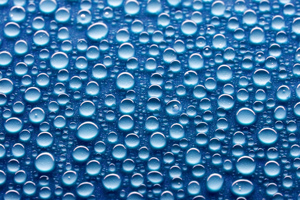Extremely repellent surfaces

Superhydrophobic surfaces, which strongly repel water, are promising for many applications. © Yurok Aleksandrovich/iStock/Thinkstock
A computational technique to analyze how water vapor condenses on a surface patterned with an array of tiny pillars has been co-developed by an A*STAR researcher. Calculations carried out using this technique reveal that water droplets preferentially form either on top of the pillars or in the gaps between them, depending on factors such as the height and spacing of the pillars [1].
Surfaces that strongly repel water, known as superhydrophobic surfaces, are important for many industrial applications as well as self-cleaning, defrosting and anti-icing surfaces. Scientists have discovered that inherently water repellent surfaces can be made much more water repellent by patterning them with micro- or nanoscale structures.
On such surfaces, water droplets can either be suspended across neighboring protrusions or impaled between them. The transition between these two states has previously been explored experimentally and theoretically. Furthermore, the effect of microstructures on vapor condensation has been studied experimentally, but there have been few computational studies of how droplets initially form by condensation from vapor.
Now, Weiqing Ren from the A*STAR Institute of High Performance Computing and Yunzhi Li of the National University of Singapore have systematically analyzed how micropillars on a hydrophobic surface affect the condensation of water vapor. To do this, they used a powerful computational technique known as the string method, which Ren developed in a previous study.
Ren and Li used the technique to investigate the effect of parameters such as the height and spacing of the micropillars and the supersaturation and intrinsic wettability of the surface on the condensation process. They discovered that both the pathway and configuration of the initial nucleus from which droplets form ― known as the critical nucleus ― depends on the geometry of the surface patterns.
In particular, the scientists found that for tall, closely spaced pillars on a surface with a low supersaturation and low wettability, the critical nucleus prefers the suspended state, whereas for the opposite case it prefers the impaled state. By generating a phase diagram, they could determine the critical values of the geometrical parameters at which the configuration of the critical nucleus changes from the suspended state to the impaled state.
These results provide “insights into the effect of surface structure on condensation,” explains Ren, “and a quantitative basis for designing surfaces optimized to either inhibit or enhance condensation in engineered systems.”
In the future, the researchers intend to study how fluid flow affects nucleation and the wetting transition on patterned surfaces.
Reference
[1] Li, Y. & Ren, W. Numerical study of vapor condensation on patterned hydrophobic surfaces using the string method. Langmuir 30, 9567–9576 (2014).
Associated links
A*STAR article
Media Contact
More Information:
http://www.researchsea.comAll latest news from the category: Materials Sciences
Materials management deals with the research, development, manufacturing and processing of raw and industrial materials. Key aspects here are biological and medical issues, which play an increasingly important role in this field.
innovations-report offers in-depth articles related to the development and application of materials and the structure and properties of new materials.
Newest articles

First-of-its-kind study uses remote sensing to monitor plastic debris in rivers and lakes
Remote sensing creates a cost-effective solution to monitoring plastic pollution. A first-of-its-kind study from researchers at the University of Minnesota Twin Cities shows how remote sensing can help monitor and…

Laser-based artificial neuron mimics nerve cell functions at lightning speed
With a processing speed a billion times faster than nature, chip-based laser neuron could help advance AI tasks such as pattern recognition and sequence prediction. Researchers have developed a laser-based…

Optimising the processing of plastic waste
Just one look in the yellow bin reveals a colourful jumble of different types of plastic. However, the purer and more uniform plastic waste is, the easier it is to…



